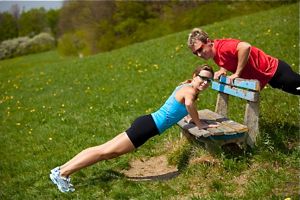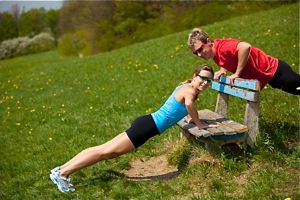 Mobile users tap and hold to share this training article.
Mobile users tap and hold to share this training article.
 Trying to answer the classic training question, “How do I get pumped?” usually leads to one thing…more questions! How many reps do I do? Should it be really heavy or moderately heavy? How many sets? How much rest between each set? How many days a week can I do this and get results? The list continues, but I think you get the point. Most training articles attempt to try and answer these questions with data, experience, and trainer opinions.
Trying to answer the classic training question, “How do I get pumped?” usually leads to one thing…more questions! How many reps do I do? Should it be really heavy or moderately heavy? How many sets? How much rest between each set? How many days a week can I do this and get results? The list continues, but I think you get the point. Most training articles attempt to try and answer these questions with data, experience, and trainer opinions.
I’m not going to do that. Instead, let’s go one step further. I want to blow up the traditional sets and reps paradigm with two programs that will end the confusion and produce amazing results. The two programs are called Escalating Density Training and the Ladder Program.
ESCALATING DENSITY TRAINING
Escalating Density Training (EDT) by Charles Staley is a timed program with two opposing exercises. Opposing can mean:
1. Push vs. Pull 2. Upper body vs. Lower Body 3. Right side vs. Left side 4. Front vs. Back
A great combo I have explored in the past are bench presses with biceps curls. You have a large, multi-joint pushing exercise coupled with a single joint pull. The key to EDT is figuring out your 10 rep max (RM). This is the amount of weight you can lift 10 times, but not 11. This is very important, because most people think you use the weight you can lift comfortably for 10 reps. That is too light and will not produce the pumped, lean muscle gain you are looking for.
Once you have determined your 10RM for the two exercises you will be doing, set a timer for 15 minutes, and begin with 5 reps of the 1st exercise, then immediately do 5 reps of the second exercise. Only rest as needed and repeat until 5 reps becomes too hard. Then drop to only 4 reps. The way you determine when to drop the reps is when you feel like you only have 2 reps left “in the tank”. In other words, every time you finish 5 reps, you should have been able to do 7 with perfect form. You never go to complete failure.
Here is a training journal entry that might help explain this more: A1) Flat bench press 185lbs. -5, 5, 5, 5, 4, 4, 4, 3, 3, 3, 3, 2, 2, 1, 1, 1 = 51 A2) Standing barbell curl 80lbs. – 5, 5, 5, 5, 4, 4, 4, 3, 3, 3, 3, 2, 2, 1, 1, 1 = 51 EDT for 15 minutes

Notice after the 4th set of 5 reps, fatigue was setting in, so I dropped to 4 reps for the next 3 rounds. By the end of the 15 minutes, I was just hitting single rep sets. My goal the next time I repeated this program would be to beat 51 reps in 15 minutes. This approach makes training like a fun game. You know exactly what your goal is the next time you train. How many times do you see people wandering around the gym wondering what they will do next? EDT can give great focus to your training program and get you excited to see if you can beat your numbers.
Once you can beat your numbers by 20%, then it is time to add 5% or 5lbs. (whichever is heavier) to the two exercises and start over. In our example, once I can achieve 62 reps of each exercise in the 15 minute time period, then I would add 10lbs. to the bench press and 5lbs. to the biceps curls for the next session and establish a new PR (personal record) with that session.
EDT is a great fatigue management system. I finished with 51 reps, but let’s say it was 50 and I tried to get that much quality work in a traditional sets and reps format. Since I used my 10RM, there is no way I could have done 5 sets of 10. Six or seven sets of 8 would have been just as tough and taken a long time. This is one of the most efficient ways to pack a lot of quality work into a short period of time.
– Lat. Pulldowns and Triceps Extensions – Squats and Shoulder Presses – Left Lunge and Right Lunge – Pullovers and Romanian Deadlifts
 THE LADDER PROGRAM
THE LADDER PROGRAMThe Ladder Program by Pavel Tsatsouline is similar to EDT in that it is a density program – a timed interval where you are accruing reps and resting as needed. What I really like about Ladders is that the warm-up is included and you can basically jump into them immediately. Also, like EDT, pick two exercises that are opposite of each other and set your timer. But this time you start with only 1 rep!
My favorite Ladder challenge is one I repeat every year for a 4 week cycle. It looks like this in my training journal:
A1) Pull-ups – 1,2,3,4,5,6/1,2,3,4,5/1,2,3,4/1,2,3,4/1,2,3/1,2/1,2/1/1/1/1 = 72 A2) Push-ups (multiples of 3) – 3,6,9,12,15,18/3,6,9,12,15/3,6,9,12/3,6,9,12/3,6,9/3,6/3,6/3/3/3/3 = 216 20 minute time limit
I did push-ups in multiples of three because I want the intensity to be equal between the two opposing exercises. Three push-ups are close to the same difficulty as one perfect pull-up for me. I just started the timer and did 1 pull-up followed immediately by 3 push-ups. I didn’t need much rest, so I immediately did 2 pull-ups and then 6 push-ups. Next came 3 and 9, then 4 and 12. At this point, I needed to rest about 20 seconds, but I still felt like I had more reps “in my tank”, so I went for 5 and 15. After another rest of 20 to 30 seconds, I did 6 and 18. At this point, the rule of not going to failure and make sure you could still do two more reps if you had too, came into effect. So I started a new “ladder” with 1 pull-up and 3 push-ups. The forward slash (/) represents the start of a new ladder. This process continues for exactly 20 minutes, then you tally your numbers and that is your PR.
The first week I tried this program, I got 50 pull-ups and 150 push-ups in 20 minutes. The example above was my 6th week total. Again, think about traditional sets and rep schemes. Typical programs suggest 4 to 6 sets of 8 to 12 reps. For me to meet the same number of pull-ups and push-ups, I would need to do 7 sets of 10 pull-ups, and 7 sets of 30 push-ups. Talk about the potential for some sloppy sets. I would need a lot of rest, and quality would be compromised. This is the most efficient way to get the most work in the shortest period of time.
It is amazing the motivation a timer and a PR can bring to your workouts. You will do anything to beat your numbers, and that is where density training becomes fun and challenging. If you can do more work in the same time period, then there are a lot of good things happening in your body as you adapt to the challenge. You need less rest to recover, and you become better at managing fatigue and maintaining your strength for longer periods.
You can play around with the time interval that is right for you. When I am introducing new clients to this program, I often have them go for an eight to ten minute ladder, depending on their fitness level.
Here’s a fun and quick 30 minute bodyweight workout with “mini” ladders: A1) Pull-ups A2) Squats (multiples of 2) 8 minute Ladder Rest 2 minutes B1) Push-ups B2) Left Lunge B3) Right Lunge 8 minute Ladder Rest 2 minutes C1) Hanging Hip flexions (focus on abs creating movement) (multiples of 2) C2) Burpee 8 minute Ladder
EDT VS. LADDERS – PROS AND CONS
Simply put, there are not many. I prefer EDT with weight-resistance exercises because of the 10RM requirement. I like Ladders better with body-weight movements, because of the unlimited potential to just keep doing more reps as your body adapts. However, these are only my preferences and you can interchange them as needed. As I mentioned, Ladders are easier to set-up and jump into with a busy schedule, because the first ladder can act as your warm-up. Ladders also offer more flexibility…you can use the same 10RM rule if using Ladders with weight-resistance exercises, but I have also used this format for heavy Olympic lifts like the Clean and Jerk.
SAMPLE EDT AND LADDER COMBO PROGRAM
 Jason Rhymer, is a training department contributor and previously served as the Training Department editor for Faith & Fitness Magazine. He is the president of Rhymer Fitness and a Z-Health Level IV Trainer. Drawing on science, faith, creativity and his personal fitness background, Jason meets the physical, spiritual and social needs of our reader. He leads Christian Fitness Bootcamps at two church locations and served during the summer of 2010 in Brazil doing ministry with Myers Park United Methodist Church.CONTACT JASON with training questions or ideas for our Training Department. For more training ideas read Jason’s Blog.
Jason Rhymer, is a training department contributor and previously served as the Training Department editor for Faith & Fitness Magazine. He is the president of Rhymer Fitness and a Z-Health Level IV Trainer. Drawing on science, faith, creativity and his personal fitness background, Jason meets the physical, spiritual and social needs of our reader. He leads Christian Fitness Bootcamps at two church locations and served during the summer of 2010 in Brazil doing ministry with Myers Park United Methodist Church.CONTACT JASON with training questions or ideas for our Training Department. For more training ideas read Jason’s Blog.










